01-09-2014 | Original Paper
The Role of Supported Joint Engagement and Parent Utterances in Language and Social Communication Development in Children with Autism Spectrum Disorder
Gepubliceerd in: Journal of Autism and Developmental Disorders | Uitgave 9/2014
Log in om toegang te krijgenAbstract
This study examined associations between three parent–child engagement states and social communication, expressive language, and receptive language at 8 month follow-up, in 63 preschool-age children with autism spectrum disorder. We extend the literature on supported joint engagement by dividing this state into higher order (HSJE) and lower order types, with HSJE involving greater reciprocity in toy play. We also examined parents’ follow-in utterances that co-occurred with each state. We found that only HSJE predicts later social communication and expressive language, while object engagement predicts receptive language. HSJE combined with follow-in utterances (HSJE+FI) predicts all three outcomes when controlling for HSJE+FI in other engagement states. When controlling for total HSJE, HSJE+FI is predictive of receptive language.
